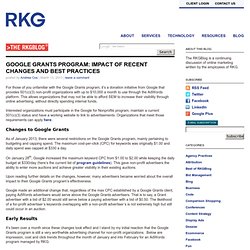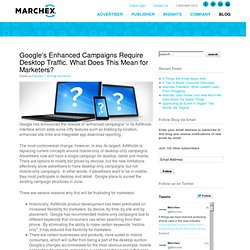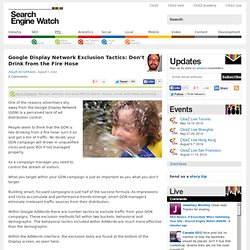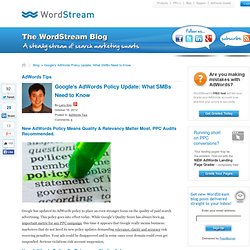

5 Ways to Beat Your Competitors With Killer PPC Ad Copy. Are your PPC conversions making you feel small?

Take a closer look at your ad copy. Image source. Have you ever wondered how some PPC marketers write ad copy that consistently performs better than yours? For a long time, I did – until I decided to learn how to beat my competitors. After reading countless blog posts and running all kinds of A/B tests, I’ve learned what works in the world of PPC ad copywriting (and what doesn’t).
Jun @ SEO Web Junction. Create image ads in different sizes - AdWords Help. Want to make an impression on customers with engaging graphics?

Use image ads to capture people's attention as they browse websites in the Google Display Network. The network contains thousands of sites and apps, from online newspapers to blogs to Google websites, such as Blogger. Image ads give you a way to entice customers to your website, using a combination of graphics and text. In this article, you'll learn about: Supported ad sizes for images ads on desktops High-end mobile devices How to create image ads How to use the Ad gallery If you've browsed websites and seen large graphic ads across the top of a webpage, then you're already familiar with what image ads look like. Snazzy, huh? Example Let’s say you sell hand-knitted scarves online and you want to generate more sales. Supported ad sizes and formats Before creating your ad in AdWords, you’ll need to prepare an image file that is sized and formatted appropriately. Acceptable file formats: .GIF, .JPG, .JPEG, .PNG, .SWF Tips Tip. Guide to ad sizes - AdSense Help.
4 Google AdWords Updates You Might Have Missed. Google AdWords has launched a series of new changes for advertisers, including updates to AdWords Editor, a new Display Benchmarks Tool, and improvements to enhanced campaigns with flexible bid strategies. Here's a recap of the latest AdWords updates. 1. Google AdWords Keyword Planner The biggest news from AdWords for many webmasters is the introduction of a brand new keyword tool combined with a traffic estimator, called the Keyword Planner . The new tool allows you to find new keywords related to a keyword or keyword list, URL, or category, which can be very helpful for those trying to do keyword research or expand their targeting keywords. You can also use it to get performance and cost estimates, which can be helpful for planning out potential budgets before actually putting it in action. Lastly, you can import the data and use it in your account without having to manually enter it from other research tools. 2. How Will Enhanced Campaigns Affect AdWords' Conversion Optimizer?
Many Google AdWords advertisers are taking the plunge and upgrading to enhanced campaigns . The deadline is looming on the horizon (July 22). With so many elements changing in the AdWords management flow, advertisers are scrambling to ensure all details are accounted for. One area of interest is how campaigns that utilize Conversion Optimizer (CO) will be affected. CO is such a powerful tool, but will it continue to function when you combine device targeting and start applying bid multipliers? Device Segmentation. Google Grants Program: Impact of Recent Changes and Best Practices. Posted by Andrew Cox | March 13, 2013 | leave a comment For those of you unfamiliar with the Google Grants program, it’s a donation initiative from Google that provides 501(c)(3) non-profit organizations with up to $10,000 a month to use through the AdWords platform.

This allows organizations that may not be able to afford SEM to increase their visibility through online advertising, without directly spending internal funds. Interested organizations must participate in the Google for Nonprofits program, maintain a current 501(c)(3) status and have a working website to link to advertisements. Organizations that meet those requirements can apply here. Google AdWords vs. Yahoo Bing Network – A PPC Performance Comparison. Every search marketer knows Google dominates in U.S. search volume, handling two-thirds of all search queries.

And yet, less is known about the entity that reportedly accounts for roughly the other third of searches – the Yahoo Bing Network (YBN). This brings up a number of interesting questions for paid search marketers. For example: Is Google dominant in every vertical? How do the two engines compare on click-through rate (CTR) and cost per click (CPC)? AdGooroo (disclosure: I work there) addressed these questions in a recent study comparing the paid search performance of advertisers on Google AdWords and Yahoo Bing across six verticals in the U.S. during Q3 2012:
Institute : Google's Enhanced Campaigns Require Desktop Traffic. What Does This Mean for Marketers? Google has announced the release of “enhanced campaigns” in its AdWords interface which adds some nifty features such as bidding by location, enhanced site links and integrated app download reporting.

The most controversial change, however, is also its largest. AdWords is replacing current concepts around mobile-only or desktop-only campaigns. Advertisers now will have a single campaign for desktop, tablet and mobile. There are options to modify bid prices by devices, but the new limitations effectively allow advertisers to have desktop-only campaigns, but not mobile-only campaigns. In other words, if advertisers want to be in mobile, they must participate in desktop and tablet. There are several reasons why this will be frustrating for marketers: Historically, AdWords product development has been predicated on increased flexibility for marketers: by device, by time, by site and by placement. Having said that, there are some big opportunities at hand: Google Display Network Exclusion Tactics: Don’t Drink from the Fire Hose. One of the reasons advertisers shy away from the Google Display Network (GDN) is a perceived lack of ad distribution control.

People seem to think that the GDN is like drinking from a fire hose: turn it on and get a ton of traffic. No doubt, your GDN campaign will drown in unqualified clicks and poor ROI if not managed properly. As a campaign manager you need to control the stream of visitors. What you target within your GDN campaign is just as important as you what you don’t target. Building smart, focused campaigns is just half of the success formula. Expand Your Marketing Reach with the Google Display Network. Image from Roy Morejon Google’s display network is vastly larger than search.
Search inherently works, and it’s the place every new advertiser should start. Google's AdWords Policy Update: What SMBs Need to Know. New AdWords Policy Means Quality & Relevancy Matter Most.

PPC audits recommended. Google has updated its AdWords policy to place an even stronger focus on the quality of paid search advertising. This policy goes into effect today. While Google’s Quality Score has always been an important metric for any PPC campaign, this time it appears that Google really means business: marketers that do not heed its new policy updates demanding relevance, clarity and accuracy risk receiving penalties. Your ads could be disapproved and in some cases your domain could even get suspended. New AdWords Policy on Relevance, Clarity, & Accuracy The new AdWords policy focuses on enforcing standards of relevance, clarity and accuracy in text ads, ensuring that users aren’t misled by your ad messaging. I think this is serious stuff, especially for small businesses with limited time and money for search marketing.